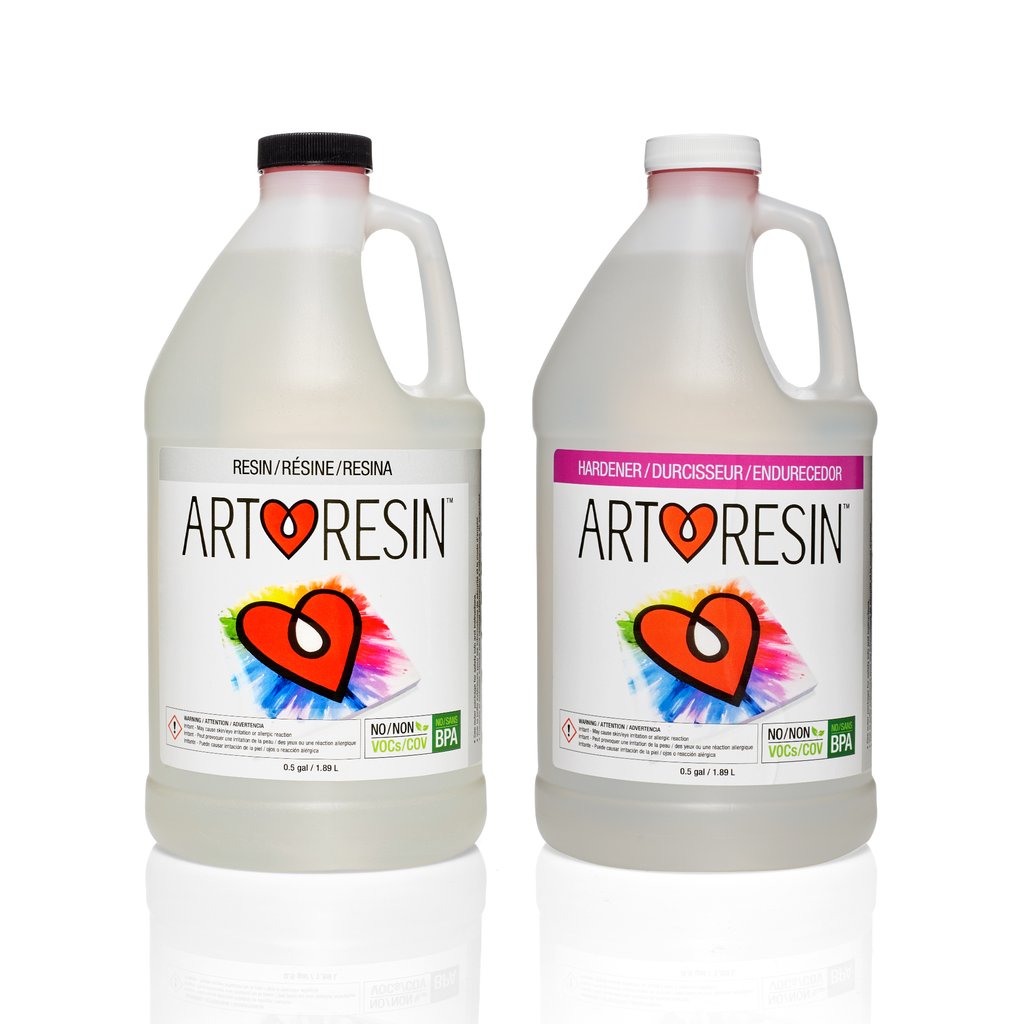A successful resin project starts with mixing your resin and hardener the right way. This guide shares important tips, techniques, and instructions to help you get reliable results every time.
Epoxy resin has two parts: resin (Part A) and hardener (Part B). To harden properly, they need to be mixed in the exact ratio listed on the label. Many resin brands use a 1:1 ratio, but it's important to follow the label directions for the specific resin you're using.
How To Get A Perfect Pour:
- Determine how much epoxy resin you'll need
- Accurately measure both resin and hardener
- Mix for 3 minutes, scraping the sides and bottom of the container as you stir
ArtResin is a high-gloss epoxy resin designed to give artwork and
creative projects a crystal clear finish. It's an easy-to-use, 1:1 ratio epoxy resin, meaning it uses equal amounts of resin and hardener, measured by volume.
Essential Tools & Materials
- Epoxy resin and hardener (check the label for specific mixing ratios)
- A graduated measuring cup
- A flat-edged mixing stick or spatula
- A spreader
-
Protective gloves
Step 1: Determine How Much Resin You'll Need
Not sure? No problem!
ArtResin has a handy resin calculator on our website that figures it out for you.
- Measure your piece. The calculator works in inches or centimetres.
- Head to ArtResin.com and click on Calculator on the top menu
- Choose your shape (Rectangular or Circular), enter your dimensions, and hit Calculate.
The Calculator tells you how much ArtResin you'll need and even recommends which kit you need.
Example: Say you have a piece of artwork that is 2 feet x 3 feet.
Enter 24 x 36" into the Calculator to get a result of 30 fl oz total resin required, made up of 15 oz of resin and 15 oz of hardener.
The 32 oz kit is the perfect amount for your project's needs.
💡 TIP: The amounts shown on the resin Calculator are for one layer only. If you're planning to do multiple coats, multiply that amount by the number of layers to find out how much resin you'll need in total.
Step 2: Measure Your Resin Accurately
ArtResin is a 1:1 epoxy resin, and requires precisely equal amounts of both resin and hardener in order to catalyze and cure. After you've prepped your work surface and determined how much ArtResin you need, pour equal amounts by volume of resin and hardener into a plastic mixing cup with well marked measurement lines.
💡 Measure Accurately: Adding too much of either resin or hardener will alter the chemical reaction and the mixture will not cure properly.

3 Simple Steps For Mixing Resin & Hardener:
| Step | Description | Important Tips |
|---|---|---|
| Step 1: Determine Quantity | Determine exactly how much resin and hardener you need based on your project's dimensions. |
• Use ArtResin’s online calculator |
| Step 2: Measure Accurately | Measure equal parts resin and hardener by volume (not weight) using a clear, graduated plastic cup. | • Follow the 1:1 ratio precisely • Use plastic tools for easy cleanup • Measure one bottle at a time to avoid mixing up the caps |
| Step 3: Mix Thoroughly |
Mix for 3 full minutes, making sure to scrape the sides and bottom of the cup so everything gets combined. | • Set a timer • Scrape when you're mixing the resin, but not when you pouring it out. • Torch the resin after pouring to remove bubbles |
Step 3: Mix The Resin For 3 Minutes
Once you've measured the correct amounts of resin and hardener, go ahead and mix slowly, for at least 3 whole minutes. Scrape the sides and bottom of the container as you mix. Improperly mixed resin stuck to the sides and bottom won't cure, leaving sticky spots in your resin that won't harden.
If bubbles appear, don't worry ... this will be eliminated after you've poured and spread the resin by using a torch like our Maker's Studio Torch.
After mixing, you’ll have about 45 minutes to spread the resin and torch bubbles before the resin becomes to thick to work with.
💡 TIP: It's important to scrape the sides and bottom of your container during mixing, but avoid scraping when you pour ArtResin onto your artwork—like scraping cake batter from a bowl into a pan. Any unmixed resin or hardener from the container sides can cause soft, uncured spots in your final finish. To learn more, see our blog post: Avoid Scraping The Sides Of Your Mixing Container When Your Pour Resin.

Our Favorite Tips
- ArtResin is sticky: wear disposable gloves to protect your hands from a sticky mess and skin irritation. If your skin does come into contact with ArtResin, clean the affected area promptly with soap and water. Read more about safety precautions when working with ArtResin.
- Use Plastic Tools: ArtResin doesn't stick to plastic, so it makes clean-up so much easier! See our 2 favorite ways to clean plastic containers and tools.
-
Ideal Temperatures = Perfect Results: The ideal temperature for working with ArtResin is 75-85°F or 24-30°C. Colder than this causes the resin to become thick and full of micro-bubbles. Precautions during the winter months include space heaters to increase room temperature and a warm water baths for resin and hardener bottles (prior to measuring). Warm your bottles in the bath for about 15 mins and dry the bottles before opening them: water in your mixture can cause resin to cure cloudy. Be aware that warming ArtResin shortens its 45 minute working time by approximately 10 minutes.
-
Mix A Little More: Prepare slightly more than you need to ensure you can cover your entire project in one go and avoid last-minute mixing.
-
Measure One Bottle At A Time: This will help make sure you put the correct cap back on the bottles (black for resin and white for hardener). If you put the wrong caps back on, they will cure closed!
- Follow The Label Directions: Adding more hardener to the mixture won't speed up the cure or make the resin cure harder. In fact, it will throw off the mixing ratio and your resin will not cure properly at all. If you want to encourage a faster cure, increase the room temperature, since curing is accelerated by heat.
Common Mistakes to Avoid
Even experienced users can make mistakes. Here are some common pitfalls to watch out for:
- Not Measuring Accurately: If the ratio is off, the chemical reaction that transforms the mixture from liquid to solid cannot occur.
- Not Mixing Well: Incomplete mixing can result in soft spots or uneven curing.
- Ignoring Recommended Temperature: Curing epoxy in extreme temperatures—both hot and cold—can affect its performance.
- Using Contaminated Tools: Ensure all tools are clean and dry to avoid introducing impurities into the mixture.
- Not Following Safety Precautions: Always wear the proper PPE and safety precautions for the specific resin you're using.
Are There Minimum Amounts I Need To Mix?
No, there are no minimum amounts you need to pay attention to when mixing up a batch of ArtResin. As long as you follow the 1:1 ratio of resin and hardener and mix thoroughly for 3 minutes, you should have success!
💡 TIP: Try saving the measuring caps that come with kids' medicine - they're usually marked with measurement lines as little as 2.5ml. You can also order small measuring cups and beakers online.
Can I Weigh The Resin & Hardener?
Yes, if you prefer, you can weigh the resin and hardener instead.
However, because the resin and hardener have different weights, the 1:1 ratio will no longer work when weighing. Instead, you will need to measure 100 parts resin to 84 parts hardener. At this weight, the volume will be accurate to 50/50 and you can proceed with confidence.
Watch And Review:
Now that your resin is measured and mixed, you're ready for the fun part ... How To Pour And Spread ArtResin over your artwork!
Questions or have a tip of your own?
Let us know in the comments below.
Read our blogs to learn more about mixing & pouring epoxy resin:
- How Do I Know When Resin Is Fully Mixed And Ready To Use?
- Is It Possible To Overstir My ArtResin?
- How To Pour And Spread Epoxy Resin
- What Is The Working Time of ArtResin?
-
ArtResin: The Original Epoxy For Resin Art.



